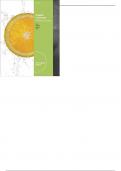,Chapter 1 -- Bonding and Isomerism
MULTIPLE CHOICE
1. What is the most electropositive element?
A) Li
B) Be
C) B
D) C
E) N
ANS: A TOP: Valence, Bonding, and Lewis Structures
2. Which of the following elements has three electrons in the valence (outer) shell?
A) C
B) B
C) S
D) F
E) N
ANS: B TOP: Valence, Bonding, and Lewis Structures
3. Which of the following would you expect to have ionic bonds?
A) HBr
B) CO
C) ICl
D) CsF
E) NF3
ANS: D TOP: Valence, Bonding, and Lewis Structures
4. Which of the following would you expect to have polar covalent bonds?
A) MgF2
B) N2
C) F2
D) NF3
E) NaF
ANS: D TOP: Valence, Bonding, and Lewis Structures
5. Which molecule has nonpolar covalent bonds?
A) NO
B) N2
C) BCl3
D) HF
E) CCl4
ANS: B TOP: Valence, Bonding, and Lewis Structures
6. The number of electrons in the valence shell of sulfur is:
A) 2
, B) 3
C) 4
D) 5
E) 6
ANS: E TOP: Valence, Bonding, and Lewis Structures
7. Which of the following elements is the most electronegative?
A) O
B) S
C) Se
D) Te
E) Po
ANS: A TOP: Valence, Bonding, and Lewis Structures
8. If the Cl–Cl bond length is 1.98Å and the C–C bond length is 1.54Å, what would you expect
the bond length of Cl–C to be?
A) 0.74Å
B) 1.54Å
C) 1.76Å
D) 1.98Å
E) 3.52Å
ANS: C TOP: Valence, Bonding, and Lewis Structures
9. Given the following electronegativity values, predict the most polar covalent bond below:
F 4.0
Cl 3.0
O 3.5
C 2.5
H 2.1
A) –F
B) C–Cl
C) C–O
D) C–H
E) C–C
ANS: A TOP: Valence, Bonding, and Lewis Structures
10. The most electronegative elements in the periodic table are generally found
A) toward the left in a horizontal row and toward the top in a column.
B) toward the right in a horizontal row and toward the top in a column.
C) toward the left in a horizontal row and toward the bottom in a column.
D) toward the right in a horizontal row and toward the bottom in a column.
E) distributed randomly throughout the table.
ANS: B TOP: Valence, Bonding, and Lewis Structures
11. Which of the following Lewis Structures for ozone (O3) is incorrect?
, A)
B)
C)
D) structures (A) and (B) are incorrect
E) none of the above structures are incorrect
ANS: C TOP: Valence, Bonding, and Lewis Structures
12. Which of the following molecules are structural isomers?
A) 1, 2, and 4
B) 1, 2, and 3
C) 1, 3, and 4
D) 2, 3, and 4
E) 3 and 4
ANS: B TOP: Valence, Bonding, and Lewis Structures
13. Which of the following abbreviated structural formulas is NOT an isomer of the others?
A)
B)
C)
D)
E)
ANS: D TOP: Valence, Bonding, and Lewis Structures
14. The number of possible acyclic hydrocarbons with the molecular formula C4H6 is




